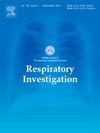Prospective investigation of the Controlling Nutritional Status (CONUT) score and clinical course of patients with COPD
IF 2.4
Q2 RESPIRATORY SYSTEM
引用次数: 0
Abstract
Background
The Controlling Nutritional Status (CONUT) score evaluates nutritional status based on the following three indices: serum albumin, total cholesterol, and peripheral blood lymphocyte count. However, the impact of the CONUT score on the clinical course of patients with chronic obstructive pulmonary disease (COPD) has not been fully investigated.
Methods
We conducted an observational study of patients with stable COPD attending our hospital. At enrollment, patients with CONUT scores of ≤1 and ≥ 2 were assigned to the normal and malnourished groups, respectively. The patients’ clinical course for up to 5 years were prospectively analyzed.
Results
We enrolled 210 COPD patients (mean age: 70.5 years, 196 men). Seventy-two patients (34.3 %) had malnutrition with a CONUT score of ≥2. These patients were significantly older, had a lower body mass index (BMI), and had lower levels of pulmonary function than those with a normal CONUT score. There were no significant differences between the two groups in sex, smoking history, previous exacerbations, asthma and COPD overlap (ACO) status, COPD Assessment Test score, or emphysema severity at enrollment. The malnourished group had significantly more COPD exacerbations during the observation period than the normal group. After adjusting for age, BMI, ACO status, COPD severity, and emphysema severity by multivariate logistic regression analysis, the presence of malnutrition with a CONUT score of ≥2 was an independent risk factor for COPD exacerbation.
Conclusion
The assessment of nutritional status by using the CONUT score may be useful in assessing the risk of exacerbation in patients with stable COPD.
慢性阻塞性肺病患者控制营养状况(CONUT)评分与临床病程的前瞻性研究
控制营养状况(CONUT)评分基于以下三个指标来评估营养状况:血清白蛋白、总胆固醇和外周血淋巴细胞计数。然而,CONUT评分对慢性阻塞性肺疾病(COPD)患者临床病程的影响尚未得到充分研究。方法对我院稳定期COPD患者进行观察性研究。入组时,CONUT评分≤1分和≥2分的患者分别被分配到正常组和营养不良组。对患者长达5年的临床病程进行前瞻性分析。结果我们纳入了210例COPD患者(平均年龄:70.5岁,男性196例)。72例(34.3%)患者存在营养不良,CONUT评分≥2。这些患者明显年龄较大,身体质量指数(BMI)较低,肺功能水平低于CONUT评分正常的患者。两组在性别、吸烟史、既往加重、哮喘和COPD重叠(ACO)状态、COPD评估测试评分或入组时肺气肿严重程度方面无显著差异。营养不良组在观察期间COPD加重明显多于正常组。通过多因素logistic回归分析调整年龄、BMI、ACO状态、COPD严重程度和肺气肿严重程度后,CONUT评分≥2的营养不良是COPD加重的独立危险因素。结论使用CONUT评分评估营养状况可能有助于评估稳定期COPD患者的恶化风险。
本文章由计算机程序翻译,如有差异,请以英文原文为准。
求助全文
约1分钟内获得全文
求助全文

 求助内容:
求助内容: 应助结果提醒方式:
应助结果提醒方式:


